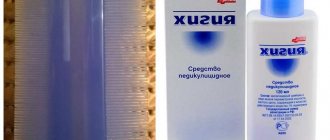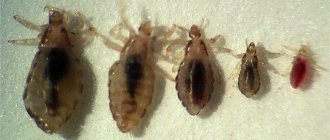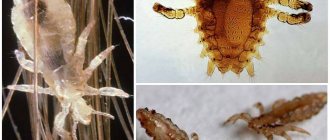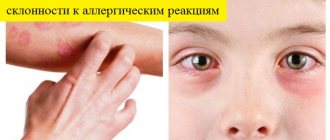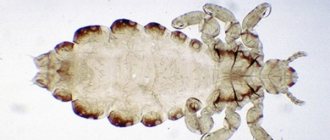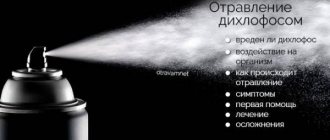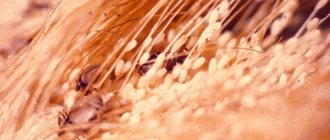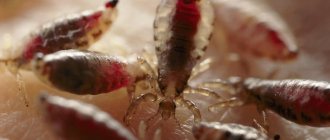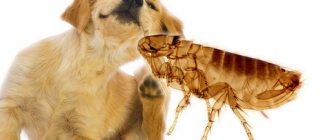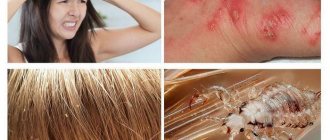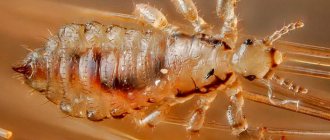Pediculosis in children: problems and concerns of parents
Kerosene, dust soap, hellebore water, fine comb or razor: among the older generation, these words are certainly associated with lice.
Pediatricians refer to head lice infestations as “pediculosis.” Although this is a completely ordinary parasitic disease caused by small insects that live on the scalp and suck blood, it is precisely this that causes a whole storm of negative emotions in parents - from anger and irritation to burning shame. In addition, the most ridiculous and funny myths are associated with this disease.
Lice: from time immemorial
Lice has accompanied people since the beginning of time. These parasitic insects are perfectly adapted to live in the hair or on the body of people.
Many sacred ancestral rituals are actually nothing more than a way to get rid of lice and prevent their recurrence.
Thus, the ancient Egyptian priests and kings, the pharaohs of Babylon and Assyria had their heads shaved so that “not a single louse would cling to the servants of the gods.”
Then lice was an indispensable companion to various wars, the life of nomadic peoples and tribes who had serious problems with hot water, soap and basic hygiene. Prisons, hard labor, overcrowding and unsanitary conditions are favorable conditions for the development of lice. When people live in cramped conditions and do not have the opportunity to properly wash, shower and tidy their hair, the appearance of various parasites is not surprising.
Why is the appearance of lice explained by nervous soil?
There is a sign that is equally characteristic of stress and head lice. It's an itch. With lice, the scalp itches unbearably. People also often scratch their heads when they are nervous. Therefore, an explanation emerged as to whether lice can appear from nervous stress. People believed that first they scratched their heads, and then lice appeared because of this. If this happened, it was a coincidence. Or the person actually caught lice, began to itch, became constantly nervous because of this, and eventually brought himself to a state of stress.
Causes of pediculosis
You can find out how the infection occurred by looking at the type of lice. Lice on the head appear from household contact with a carrier (transport, shared comb).
Unlike head lice, pubic lice are transmitted through sexual contact. The place of their influence is the pubic area.
You can become infected with body louse by wearing someone else's clothes or using someone else's bed linen (on a train, for example).
Parasites can cause serious discomfort (regardless of their type). Self-medication for infection is possible, but not recommended. It is better if a competent dermatologist examines the affected areas and subsequent therapy.
Differential diagnosis
The spread of lice has similar symptoms to other diseases. Therefore, it is important to make a differential diagnosis in a timely manner in order to begin quality treatment:
- Dermatitis
. The condition develops against the background of the spread of an allergen and nervous tension. If, before the formation of inflammatory processes on the skin, a person has been in contact with the causative agent of lice, he begins to become very nervous. Therefore, red spots appear on the skin, even in the absence of lice. - Scabies
. This is a disease with which pediculosis is often confused. Active itching forms on the skin, but it is caused by another parasite. This is a subcutaneous mite that penetrates under the epidermis. But abundant bite marks and wounds will not develop on the skin. - Psoriasis
. This is an incurable disease characterized by the appearance of white spots and severe itching. It forms in waves. People believe they get lice from scratching their skin.
To accurately determine the diagnosis, consult a doctor. For example, a therapist or an infectious disease specialist.
Symptoms of infection
Pediculosis can be detected at an early stage by the following main signs:
- itching It gets worse after washing your hair, in the evening, during sleep.
- Insect eggs (nits) are present.
- Feeling of crawling.
- Rashes in various manifestations (ulcers, papules, minor inflammations).
- Presence of excrement (like small black dots).
- Hair gets tangled and quickly gets dirty.
If you are unable to resolve the problem on your own, you should consult a dermatologist.
The first signs of lice on the head
You can suspect the presence of lice on your head based on the first signs.
In addition to itching, these include:
- deterioration of sleep.
- Irritability.
- Swelling of the lymph nodes.
To make sure you don't have parasites, it's worth doing a thorough inspection. A magnifying glass and flashlight will help you distinguish dandruff from nits.
Important: if there are too many parasites, death cannot be ruled out.
This is because lice cause both physical and psychological discomfort.
Itching
Symptoms of head lice may not appear immediately. The main sign of infection is itching. The discomfort is caused by a special enzyme that lice inject under the human skin during a bite.
It prevents the rapid clotting of blood, resulting in red blood dots remaining at the puncture site.
Please note: parasites can occur even in a small child. Since the baby, due to his age, will not be able to name the reason, he will cry constantly.
Itching of the skin bothers both day and night. If you feel discomfort during sleep, and washing your hair does not bring relief, you should examine your head for lice.
Bite sites
Lice bites are also signs of lice.
Most often, insects bite in places such as:
- temple area.
- The area behind the ears.
- The back of the head.
Spots of gray-blue shades may appear here. They are not dangerous, but clearly indicate a problem.
A red spot remains at the site of the bite, in the center of which a puncture can be seen. If the scale of infection is large, the spots merge, forming local redness. Scratching bites leads to the formation of wounds and crusts.
Tangles, hair gluing
One of the sure symptoms of the presence of lice on the head is the formation of tangles. Hair begins to stick together if the parasite carrier does not have the opportunity to wash his hair regularly (vagrancy, long expedition).
The eggs are attached to the hair by a special adhesive substance secreted by female lice. If an insect holds on to several hairs at once, they will all stick together.
With the complication of pediculosis, the number of glued tufts of hair increases, after which tangles begin to form.
Other symptoms
Symptoms of the disease worsen over time:
- nervousness.
- Pyoderma (purulent lesion of the skin).
- Sleep problems.
- Increase in temperature.
Sometimes these signs are complicated by the body’s allergic reaction to multiple bites. Knowing how to detect lice can help diagnose the disease in the early stages.
Signs of nits
The main sign of the presence of nits is parasites. When it gets on the hair, the female almost immediately lays eggs. After a week or a week and a half, new lice hatch from them, and the cocoons themselves remain hanging on the hair.
Visually, parasite eggs are very similar to dandruff. You can distinguish nits from skin flakes by their size and structure.
Body lice
Body lice (linen, clothes) reach 5 mm in length.
Habitats of the parasite:
- clothes and bed linen.
- Blankets.
- Mattresses.
The main symptom of this type of lice is itching of the skin under clothing. A person may feel like someone is running all over them. The reasons for its appearance are usually associated with the use of someone else's clothes and underwear.
Video
Where will the louse jump?
What lice and nits look like
The appearance of insects allows them to hide well in the hair.
Signs by which ectoparasites can be recognized:
- oblong body, similar to grains of rice.
- Small sizes (up to 5 mm).
- Color gray, brown. The shade changes when the louse becomes saturated.
Good fixation of lice on the hair is facilitated by the presence of paws with claws. The antennae are responsible for the sense of smell, but vision is completely absent.
Special needles help to carry out the puncture. To feed with blood, there is a proboscis that works like a pump.
The larvae mature in nits - special capsules with a lid. They are similar to dandruff, but are much smaller in size (up to 1 mm) and when pressed they produce a characteristic squeak.
Favorable conditions for the development of lice
Temperature and humidity are of greatest importance for the development of pediculosis. The optimal temperature for the development of lice is about +30 degrees Celsius, then the larva emerges from the nit in the shortest possible time, and the nymph grows to an adult as quickly as possible.
If the air temperature drops to +10 degrees, this leads to a slowdown in development for several days. At an air temperature of -10 degrees, adults and nymphs die in 1-2 hours. For nits to die, an air temperature of no higher than -20 degrees is required, since they are attached to the roots of the hair and they have natural “heating” from the human body.
Elevated temperatures also lead to the death of lice. For adults, the lethal temperature is +50 degrees, for nits +60 degrees. Even if the temperature has reached +40 degrees, under such conditions the adults stop feeding and reproducing.
Diagnostic methods
After the initial infection with the pathogen, there is an incubation period. It lasts 2-3 weeks. It actively multiplies, spreading throughout the body. At this stage, symptoms form:
- itching localized at the bite sites;
- wounds on the skin due to bites or active scratching of the skin;
- irritation of the epidermis;
- nits near the hair roots;
- inflammation of the hair follicle.
When a person carefully examines the skin, they may notice the presence of lice near the hair roots.
With prolonged absence of treatment, secondary symptoms develop:
- tangling and gluing of hair due to waste products of lice between the hairs;
- insomnia caused by itching;
- ulcers due to activation of secondary infection;
- dermatitis, irritation;
- lymphadenitis in the area of pathogen spread.
If a patient experiences these symptoms, the condition is most often caused by lice. It is necessary to begin timely treatment to prevent complications.
What to do if head lice is confirmed
Having identified pediculosis, it is important not to delay treatment.
Therapy should be comprehensive, consisting of 2 stages:
- Mechanical impact (combing).
- Chemical exposure (use of drugs).
A fine-toothed comb is suitable for combing. The procedure is carried out for several days in a row until the parasites are completely removed.
The use of special drugs must be agreed with a specialist. If a small child is infected, aerosols are used for ease of treatment.
Please note: the dermatologist selects the product and dosage based on the clinical picture.
Self-medication can provoke allergic reactions to drugs. During therapy, it is important to remove the larvae, because they will later develop into adults.
Complex wrestling
If you find lice in children, be sure to check the hair and heads of all other family members. Pediculosis is a highly contagious disease. One carrier will most likely affect the whole family. Everyone needs to get rid of lice. And even if you haven’t noticed any adults, it’s worth using a medicated shampoo as a preventive measure to kill nits and lice, which may remain invisible.
Lice emerge from the nits within 6–8 days. So within a week after treatment, you need to examine the heads in order to detect new individuals in time. To be on the safe side, you can repeat the treatment after 1 to 2 weeks.
Do not forget that lice can appear not only on the head, but also on the personal belongings of an infected person. They tenaciously hold on to the hair with their paws, but can simply fall onto clothes, bed, any surrounding objects, and then from there again move onto children and adults. To destroy parasites, it is advisable to treat the room where infected children or adults were. To do this, you can use different methods. In winter, you can freeze the room by turning off the heating and opening the windows for several hours. Insects die at temperatures below zero, but this is a very radical method. You can use chemical preparations with an acute pediculicidal effect, for example, Medilis-Malathion, Medilis-Permifen, Medilis-Super. They treat surfaces by wiping or spraying. Clothes can be soaked in a pediculicide solution and washed at temperatures above 40 degrees.
It is worth remembering that the comfortable temperature for lice is from 20 to 37 degrees. At levels lower and higher, they stop reproducing and living. They also constantly need food. Without blood, they can live up to 4 days, but more often they die after two days. Nits can fall into a state of suspended animation and spend up to a month in it, after which – when they find themselves in comfortable conditions – they continue their development. So if there are things affected by lice or nits that cannot be washed or treated in any other way, you can simply put them in sealed bags and leave them there for a month. During this time, the pests will die.
